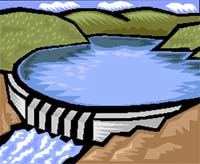|
Hydropower and the Watershed TOPIC/ISSUE: Seattle City Light manages the hydroelectric plant located in the Cedar River Watershed. The City must balance the instream flow requirements with the City’s need for drinking water. Now, with the onset of the energy crisis, the City must consider the impact on fish flows as they try to meet the energy and water consumption demands of the community. The choice seems fairly clear as George Schneider, Water Resource Manager for SPU stated "the city might boost power production if public safety was at stake, but not simply for financial reasons." Since 1901, Seattle has diverted water from the Cedar River at Landsburg. In 1914, the concrete Masonry Dam was completed. This increased storage at Chester Morse and provided the City of Seattle with its first hydroelectric plant. Initially, capacity was only 2.4 MW but strong demanded called for expansion. In 1921 and 1929, two turbines were constructed. Now, the plant can generate up to 30 MW of power. – enough electricity for 30,000 homes. Typically, though, the plant produces about 17 MW. When at full capacity, the plant meets about 1.5% of Seattle City Light’s total needs. The water travels from Chester Morse Lake and Masonry Pool to Masonry Dam, where it is diverted into two 78 inch pipes (penstocks) for 2 ½ miles, creating the pressure necessary to turn the turbines. Cedar Falls Hydroelectric Plant is unmanned but supervised 24 hours/day through electronic monitoring. Energy generated is interconnected with Puget Sound Energy’s (PSE) electric transmission system. PSE’s grid interconnects with the Seattle City Light’s transmission system. Volumes in excess of that needed for the power plant spill over the dam or flow directly into a bypass line and travel an additional 12 miles to the Landsburg diversion dam. |
